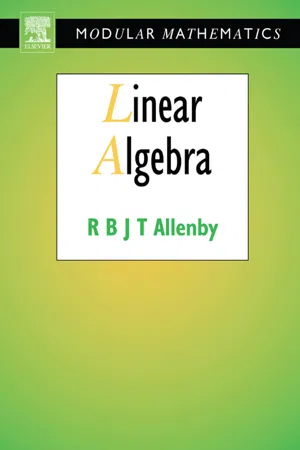
eBook - ePub
Linear Algebra
Reg Allenby
This is a test
Compartir libro
- 240 páginas
- English
- ePUB (apto para móviles)
- Disponible en iOS y Android
eBook - ePub
Linear Algebra
Reg Allenby
Detalles del libro
Vista previa del libro
Índice
Citas
Información del libro
As the basis of equations (and therefore problem-solving), linear algebra is the most widely taught sub-division of pure mathematics. Dr Allenby has used his experience of teaching linear algebra to write a lively book on the subject that includes historical information about the founders of the subject as well as giving a basic introduction to the mathematics undergraduate. The whole text has been written in a connected way with ideas introduced as they occur naturally. As with the other books in the series, there are many worked examples.
Preguntas frecuentes
¿Cómo cancelo mi suscripción?
¿Cómo descargo los libros?
Por el momento, todos nuestros libros ePub adaptables a dispositivos móviles se pueden descargar a través de la aplicación. La mayor parte de nuestros PDF también se puede descargar y ya estamos trabajando para que el resto también sea descargable. Obtén más información aquí.
¿En qué se diferencian los planes de precios?
Ambos planes te permiten acceder por completo a la biblioteca y a todas las funciones de Perlego. Las únicas diferencias son el precio y el período de suscripción: con el plan anual ahorrarás en torno a un 30 % en comparación con 12 meses de un plan mensual.
¿Qué es Perlego?
Somos un servicio de suscripción de libros de texto en línea que te permite acceder a toda una biblioteca en línea por menos de lo que cuesta un libro al mes. Con más de un millón de libros sobre más de 1000 categorías, ¡tenemos todo lo que necesitas! Obtén más información aquí.
¿Perlego ofrece la función de texto a voz?
Busca el símbolo de lectura en voz alta en tu próximo libro para ver si puedes escucharlo. La herramienta de lectura en voz alta lee el texto en voz alta por ti, resaltando el texto a medida que se lee. Puedes pausarla, acelerarla y ralentizarla. Obtén más información aquí.
¿Es Linear Algebra un PDF/ePUB en línea?
Sí, puedes acceder a Linear Algebra de Reg Allenby en formato PDF o ePUB, así como a otros libros populares de Mathématiques y Théorie des nombres. Tenemos más de un millón de libros disponibles en nuestro catálogo para que explores.
Información
Categoría
MathématiquesCategoría
Théorie des nombres1
Systems of Simultaneous Linear Equations
Solutions of systems of simultaneous linear equations (also called linear systems) arise in very many real life situations; for just a couple of instances see the Applications at the end of the chapter. Here we show how to solve such systems (much as a computer would) by simplifying them in a systematic way. We shall also see how to interpret the results we obtain geometrically.
In 1849 the French mathematician Joseph Alfred Serret (30 August 1819–2 March 1885) wrote: ‘Algebra is, properly speaking, the analysis of equations.’ (This is no longer an accurate statement – although the motivating factor behind the theory of groups was the investigation of the solutions of polynomial equations.) Accordingly, linear algebra should (amongst other things) involve the study of linear equations – that is, equations involving the ‘unknowns’ (or ‘indeterminates’ or ‘variables’) x, y, z,… from which terms such as √x, xy, xy3z2, ex, sin x, 1/x, log x, etc. which are not of degree 1 in the variables, are excluded. The prefix ‘linear’ derives from the fact that such equations can, at least in the case of two and three unknowns, be represented geometrically by straight lines and planes in 2- and 3-dimensional space. In particular, linear algebra is much concerned with finding the solutions to a given system of simultaneous linear equations. We will begin by looking at some simple examples.
• Example 1
Solve


Recall that, to ‘solve’ the pair of equations (1.1) and (1.2) simultaneously, we must find all possible (pairs of) values of x and y which make both (1.1) and (1.2) true at the same time.
To obtain the full solution to Example 1 we may eliminate x, say, from equation (1.2). We can do this by taking twice equation (1.2) from three times equation (1.1) - in brief 3x(1.1)-2x(1.2) – which gives

that is,

Thus equations (1.1) and (1.2) are replaced by the pair


Equation (1.3) tells us at once that y = −1 and then (1.1) can be used to deduce that x = 4.
As an example (with somewhat more adventurous coefficients!) let us try the following.
Example 2
Solve


Proceeding as in Example 1, we obtain a new third equation by forming 7.8x(1.4)-6.8x(1.5).
This gives (!)


Since there are no numbers x and y satisfying (1.6) we infer that the given pair of equations can have no (simultaneous) solution.
As a final example consider the (almost identical) equations in the following.
Example 3
Solve


This time 7.8x(1.4)-6.8x(1.7) leads to


Here equation (1.8) imposes no restrictions whatsoever on x and y and so it can be ignored. Indeed the pair of equations (1.4) and (1.7) is see...